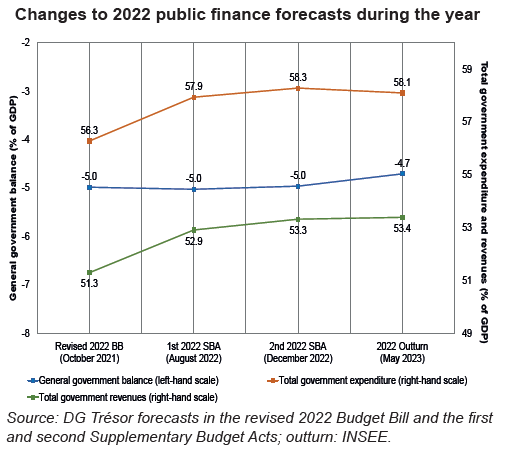Public Deficit on Target in 2022 Despite the Energy Crisis
The 2022 public deficit stood at 4.7% of GDP, which was similar to the target stipulated in the 2022 Budget Bill drafted in the third quarter of 2021. This Bill could not foresee either the scale of the 2022 energy shock nor that of the measures implemented to support households and businesses. On the other hand, the capacity to revise forecasts rapidly and determined adherence to deficit commitments made it possible to meet the initial target, despite revenue and expenditure shocks.
The 2022 public deficit published by the National Institute of Statistics and Economic Studies (INSEE) on 31 May 2023 stood at 4.7% of GDP. This figure is close to the 5.0% of GDP target set out in the 2022 Budget Bill, as revised on 22 October 2021, and upheld in the two 2022 Supplementary Budget Acts.
However, an imported inflation shock of more than 4 percentage points in 2022 had a strong impact on revenues and expenditure through several channels.
Spontaneous growth of taxes and social security contributions outstripped GDP growth by a wide margin. This major stylised fact was incorporated into the forecasts in the first 2022 Supplementary Budget Bill in July 2022. It stemmed primarily from the components of growth, the strength of wage growth and the large increase in taxable corporate profits in 2021, which has a lagged impact on government revenues.
The inflation shock affected expenditure in two main ways: (i) the indexation of certain expenditure; (ii) the measures implemented since the end of 2021 to protect businesses and households from inflation.
In the fourth quarter of 2021, it was impossible for the Budget Bill to foresee the scale of the energy shock or the measures that would be introduced to support households and businesses. However, the capacity for rapid revisions of forecasts to allow proportionate discretionary tax measures and resolute commitments to the deficit target made it possible to attain a deficit that was close to the original target, despite the shocks affecting revenue and expenditure (see Chart).
